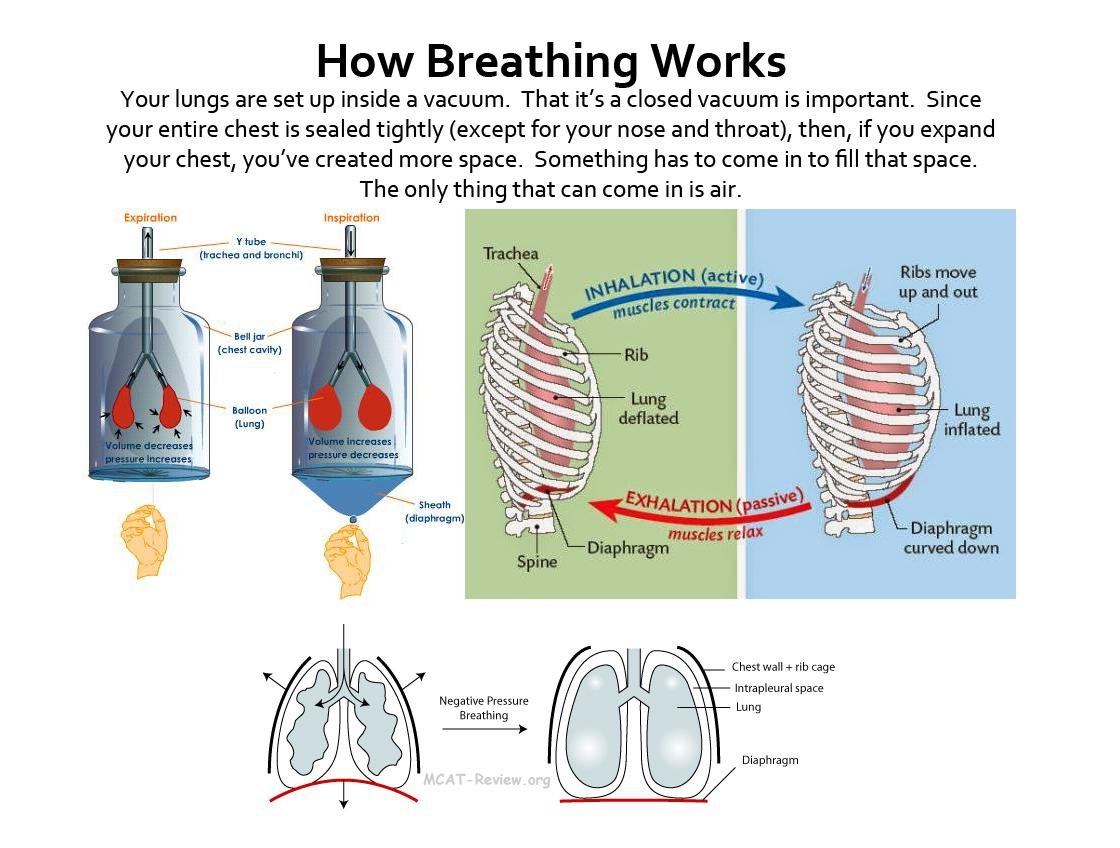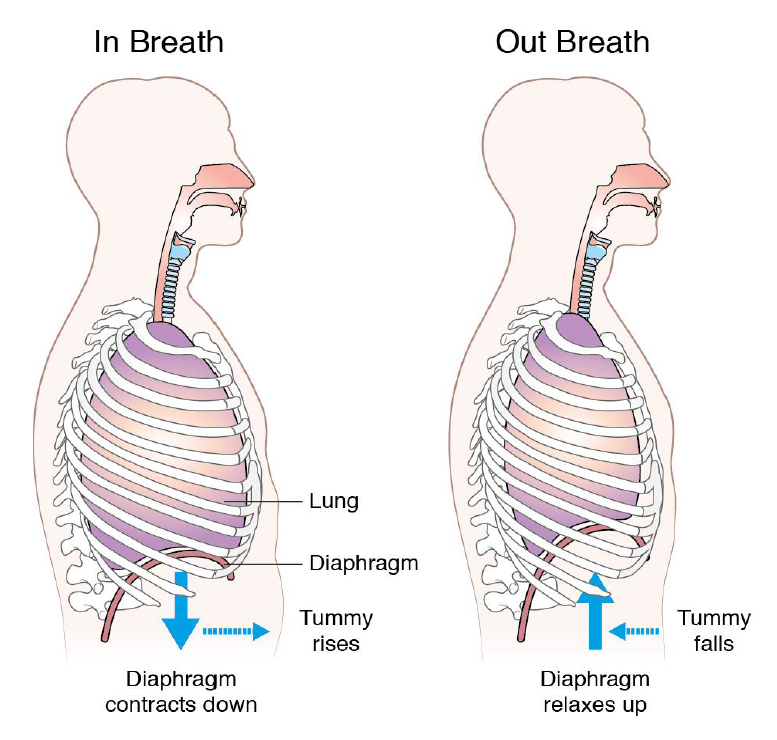Technically a kriya, or an internal cleansing technique, kapalabhati pranayama (or skull-shining breath) can help to cultivate a clear & invigorated focus while also supporting the clearing out of both stagnant energy as well as any unhelpful & unnecessary thoughts. Additionally, we'll be exploring some retentions (breath holds) with this technique.
I prefer to practice kapalabhati, ideally, first thing in the morning to kickstart my day or before other breath work, cross-training, or paddling out to surf. To me, the belly breathing plus the focus on a forceful exhale feels like a powerful way to spark a connection to my center — my core — as well as with my (our) primary breathing muscle, the diaphragm. The retentions, I feel, a nice to way to “stretch” the lungs as well as to practice enhancing the ability to stay calm in the face of stillness and, potentially, uncomfortable situations.
First, let’s take a quick look at the movement of the diaphragm and the relationship between the diaphragm and our core/abdominal cavity…
After a quick Google search, I found a couple of images that I think do a great job of painting the picture of what’s happening when we breathe:
As you can see, the diaphragm is contained within the bottom border of the rib cage, and on the inhale, the diaphragm contracts and draws down, pulling air into the lungs, and pressing the contents of the abdomen slightly forward (that’s the “belly” breath). On the exhale, the diaphragm relaxes back up into the rib cage, expelling air from the lungs, and allowing the contents of the abdomen to return to their place as well.
Before attempting kapalabhati, I think it can be really helpful to familiarize yourself with this diaphragmatic or “belly” breathing: Inhaling through your nose and “breathing into” the belly/bottom of the ribs, and exhaling through your nose feeling that relaxing or rebounding of the belly/bottom of the ribs. Before I practice kapalabhati, I personally like to take 5-10 mindful “belly” breaths to prepare.
Now let’s talk about how to do Kapalabhati…
Kapalabhati is essentially a series of forceful exhales + passive inhales, all done through the nose. To comprehend, as well as to feel, the action required to do this, let’s circle back to the relationship between the diaphragm and the core.
On the inhale the diaphragm contracts and the belly relaxes, on the exhale the diaphragm relaxes and the belly almost “rebounds” back to its natural shape.
Now, notice that if you add a slight contraction of your lower abdominals to that breath out (think around the belly button or below, like the kind of contraction you’d feel when you cough), the breath becomes a little bit more forceful. The subtle contraction helps to really expel the air (& maybe any congestion) out of the nose.
And that’s essentially how you do kapalabhati… Let’s put it together in an easier-to-follow list:
Begin by taking 5-10 mindful “belly” or diaphragmatic breaths to prepare.
Begin your first round of kapalabhati with a breath in, then move through 30-40 forceful exhalations.
Remember, the forceful exhalation is a result of a gentle contraction of your lower abdominals. The inhale is passive, as a result of relaxing your belly/abs.
If kapalabhati is still fairly new for you, begin SLOW. Don’t worry about pace or speed, just focus on technique. Aim for 3 rounds of 30-40 skull-shining breaths with 1-3 slower “belly” breaths in between.
Once this technique has become more familiar, then you can start adding in retentions. When exploring these breath holds, keep in mind the goal is not to reach a maximum time (we aren’t looking to get light-headed or to pass out), but to pay attention and notice when you’re holding your breath, where your mind wants to take you. Once you hit that first urge to breathe, try to relax & stay for just a second or two longer, then return to slow belly breathing.
Kapalabhati w/ Retentions
Begin by taking 5-10 mindful “belly” or diaphragmatic breaths to prepare.
Begin your first round of kapalabhati with a breath in, then move through 30-40 forceful exhalations at your own pace.
On your final skull-shining exhale, empty all of your breath out and hold.
Try to relax and remember to pay attention: Notice where your mind wants to take you and trust your ability to stay. Once the first urge to breathe hits you, try to relax & stay for just 1-2 seconds longer.
Then take a full “belly” breath in (through nose or mouth) and hold.
Again, relax and pay attention. Once the first urge to breathe hits you, try to relax & stay for just 1-2 seconds more, then release.
Take 1-3 slow “belly breaths” and repeat steps 2-4 for a total of 3 rounds.
Take a moment once you finish observing your breath as it returns to its natural pace & noticing how the breath work has left you feeling.
A few final notes…
While there may be small moments of discomfort, breathwork of any kind should never be extremely stressful or anxiety-provoking. I can’t highlight enough the power of going slow and paying attention. Meet yourself where you’re at and the more you practice, over time, the more familiar and comfortable it’ll become.
Depending on who you talk to, what book you pick up, or what Google links you click on, the list of contraindications for kapalabhati can sometimes seem lengthy. Often included are people with high or low blood pressure, a history of stroke, heart disease, glaucoma, recent abdominal surgery, or pregnant people. Sometimes you’ll even see/hear that kapalabhati shouldn’t be practiced during menstruation.
That all being said, I also truly believe that we each hold onto the user’s manual for our own uniquely beautiful human bodies and what works for some may not always work for others, and by paying attention to how it feels during & after the breath work, you can decide if what’s best for you. Now I also deeply support & suggest learning under the guidance of an experienced teacher, talking to your health care provider, and doing some more research on your own… But more importantly, just remember to pay attention to how it feels for you and trust that you know what you need.
Lastly, and just for an example, when I have bad cramps during my period, which cramps are often a sign of stagnation, I often find that gentle kapalabhati can actually be very soothing!!



